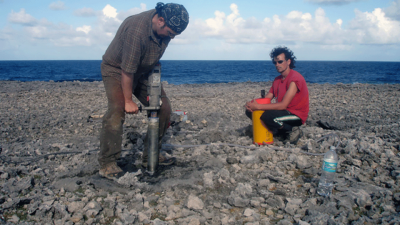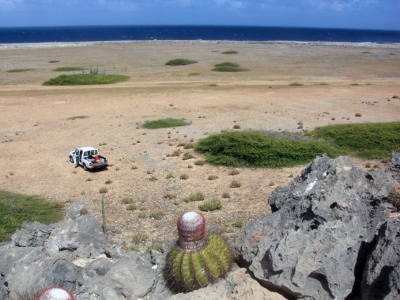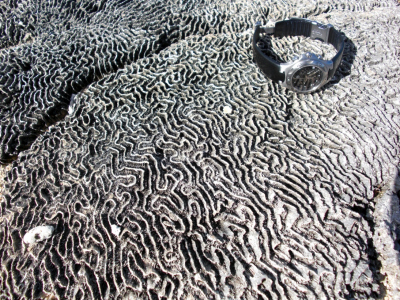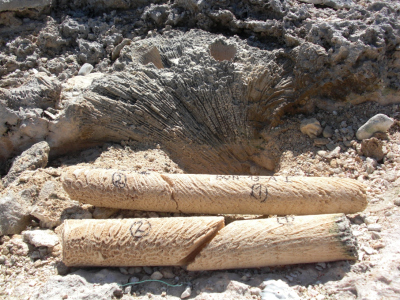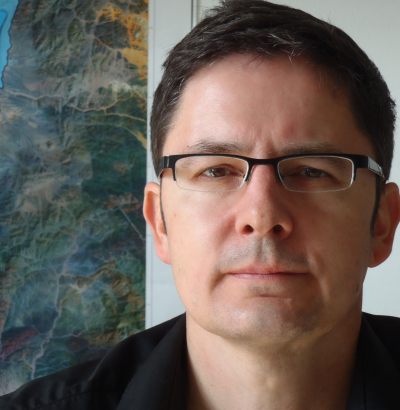Page path:
- Home
- Discover
- Media Releases
- Media Releases 2015
- Lessons from the Last Interglacial
Lessons from the Last Interglacial
All over the world scientists are making an effort to improve computer-based models in order to more precisely describe future climate scenarios and to better estimate the possible consequences and risks of global climate change. In this context, climate data from the past play an important role as they improve our understanding of climate dynamics in general. Now, an international team of scientists has investigated fossil corals that were drilled on the Caribbean island of Bonaire. This rather small and sparsely vegetated Lesser Antilles island is situated about 100 kilometres off the coast of Venezuela.
“The waters off Bonaire are part of the Caribbean Current, which transports water from the tropical Atlantic to the Gulf of Mexico. Therefore our climate data represent past temperature conditions in the northern tropical Atlantic Ocean”, says lead author Thomas Felis, who works at MARUM, the Center for Marine Environmental Sciences, at the University of Bremen in Germany.
The researchers drilled their samples from the surface layer of a fossil reef terrace, which today is about two metres above sea level. “During the final stage of the last interglacial, sea level was higher than today”, says co-author Sander Scheffers from the Marine Ecology Research Centre at Southern Cross University in Lismore, New South Wales. “Therefore we could easily retrieve our samples from land.” One of the corals dates back to 118,000 years ago. It grew during the final stage of the last interglacial. The 20-centimetre-long coral core covers a period of 20 years – a climate archive from the past containing sea-surface temperature information at a monthly resolution.
According to the new study, seasonal sea-surface temperatures varied by about 2.6 degrees Celsius back then, only 0.2 degrees less than today. The researchers subsequently performed simulations using a coupled atmosphere-ocean model: “Our model indicates an orbital control on the amount of insolation and thus on temperature seasonality in the tropical Atlantic, both at the end of the last interglacial and today”, says co-author Gerrit Lohmann, a climate modeller at the Alfred Wegener Institute, Helmholtz Centre for Polar and Marine Research in Bremerhaven, Germany: ”That means that the tilt and the rotation of the Earth`s axis and the shape of the orbit around the sun play a crucial role here.”
The fact that temperature seasonality in the distant past is not significantly different from the present is rather astonishing. Unlike today, climate conditions back then were characterized by severe turbulence. During the course of the interglacial, polar ice sheets had become instable and probably collapsed in part. Sea level rapidly rose by several metres. This freshwater inflow probably changed Atlantic Ocean currents; the European climate became extremely dry and distinctly cooler. “However,” says Gerrit Lohmann, “our data show that changes in the Greenland ice sheet or freshwater flowing into the North Atlantic only played a minor role for processes in the tropical Atlantic.”
“Considering the generally rather turbulent climate back then, temperature seasonality in the northern tropical Atlantic was rather stable”, sums up Thomas Felis. And, reflecting on future climate changes, he states: “Studies show that sea-surface temperatures in the tropical Atlantic play a major role in triggering seasonal climate extremes such as hurricanes, flash floods, and droughts. So we should keep a close eye on them.”
Please find the Nature Communications paper here.
More information / interview / images:
Albert Gerdes
MARUM Public Relations
Phone +49-421-218 65540
Email: [Bitte aktivieren Sie Javascript]
“The waters off Bonaire are part of the Caribbean Current, which transports water from the tropical Atlantic to the Gulf of Mexico. Therefore our climate data represent past temperature conditions in the northern tropical Atlantic Ocean”, says lead author Thomas Felis, who works at MARUM, the Center for Marine Environmental Sciences, at the University of Bremen in Germany.
The researchers drilled their samples from the surface layer of a fossil reef terrace, which today is about two metres above sea level. “During the final stage of the last interglacial, sea level was higher than today”, says co-author Sander Scheffers from the Marine Ecology Research Centre at Southern Cross University in Lismore, New South Wales. “Therefore we could easily retrieve our samples from land.” One of the corals dates back to 118,000 years ago. It grew during the final stage of the last interglacial. The 20-centimetre-long coral core covers a period of 20 years – a climate archive from the past containing sea-surface temperature information at a monthly resolution.
According to the new study, seasonal sea-surface temperatures varied by about 2.6 degrees Celsius back then, only 0.2 degrees less than today. The researchers subsequently performed simulations using a coupled atmosphere-ocean model: “Our model indicates an orbital control on the amount of insolation and thus on temperature seasonality in the tropical Atlantic, both at the end of the last interglacial and today”, says co-author Gerrit Lohmann, a climate modeller at the Alfred Wegener Institute, Helmholtz Centre for Polar and Marine Research in Bremerhaven, Germany: ”That means that the tilt and the rotation of the Earth`s axis and the shape of the orbit around the sun play a crucial role here.”
The fact that temperature seasonality in the distant past is not significantly different from the present is rather astonishing. Unlike today, climate conditions back then were characterized by severe turbulence. During the course of the interglacial, polar ice sheets had become instable and probably collapsed in part. Sea level rapidly rose by several metres. This freshwater inflow probably changed Atlantic Ocean currents; the European climate became extremely dry and distinctly cooler. “However,” says Gerrit Lohmann, “our data show that changes in the Greenland ice sheet or freshwater flowing into the North Atlantic only played a minor role for processes in the tropical Atlantic.”
“Considering the generally rather turbulent climate back then, temperature seasonality in the northern tropical Atlantic was rather stable”, sums up Thomas Felis. And, reflecting on future climate changes, he states: “Studies show that sea-surface temperatures in the tropical Atlantic play a major role in triggering seasonal climate extremes such as hurricanes, flash floods, and droughts. So we should keep a close eye on them.”
Please find the Nature Communications paper here.
More information / interview / images:
Albert Gerdes
MARUM Public Relations
Phone +49-421-218 65540
Email: [Bitte aktivieren Sie Javascript]
Above: A coral terrace on the eastern coast of Bonaire. Foreground: the cactus Melocactus macracanthus, Creole Milon di Seru , which means melons of the hill.
Below: Detail of the fossil brain coral Diploria strigos on the coast of Bonaire.
Photos: MARUM, University of Bremen
Just drilled: two segments of a brain coral core with a diameter of six centimetres each.
Photo: MARUM, University of Bremen
Geoscientist and first author of the Nature Communications paper, Dr. Thomas Felis.



